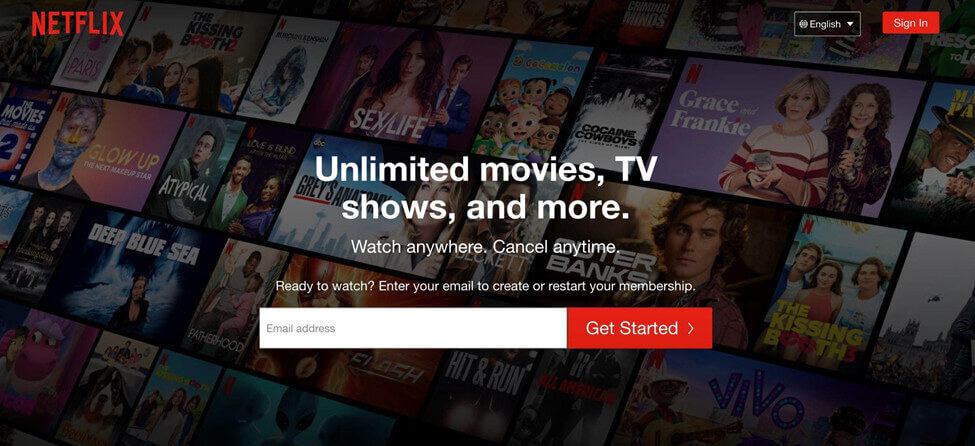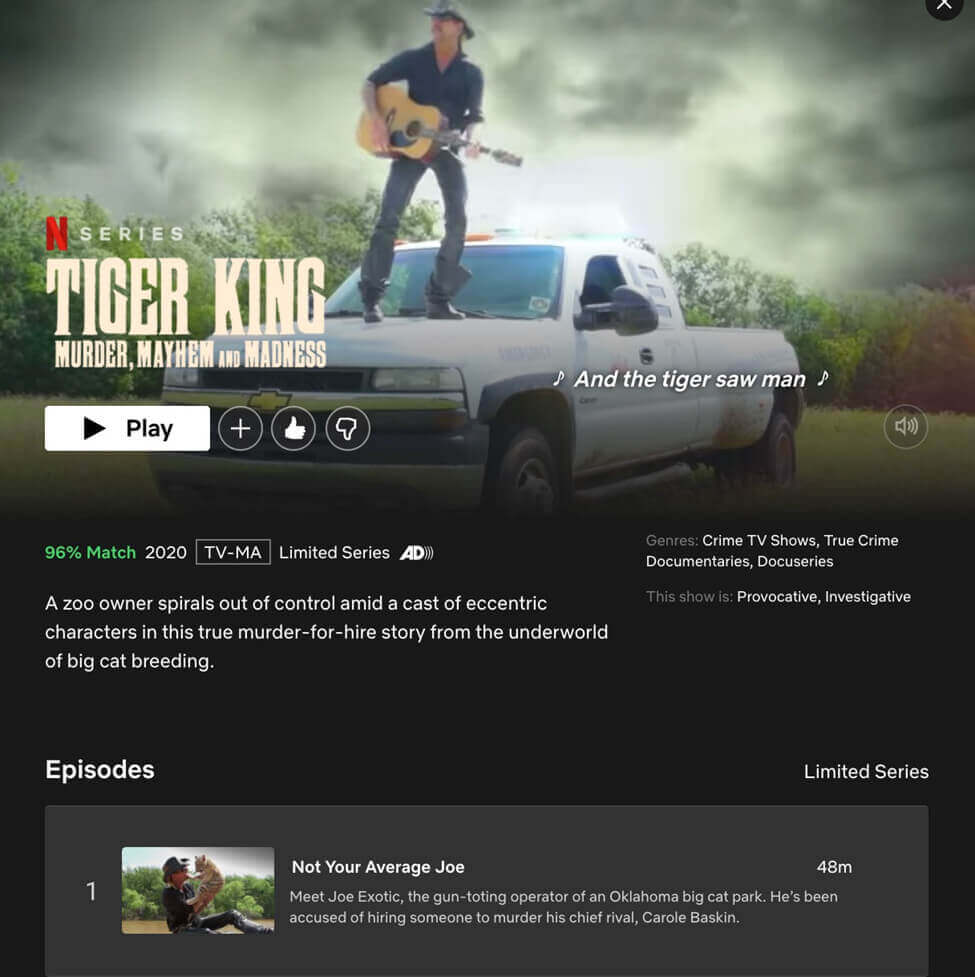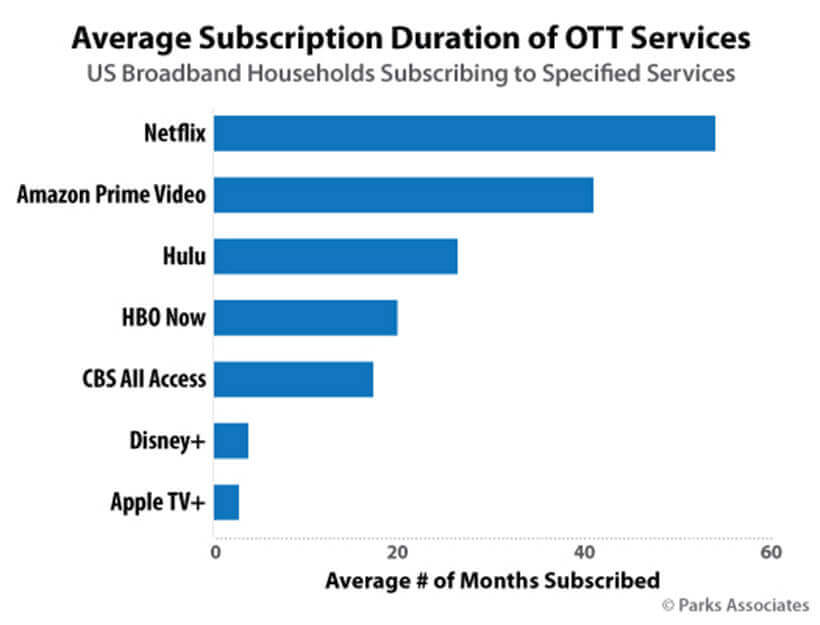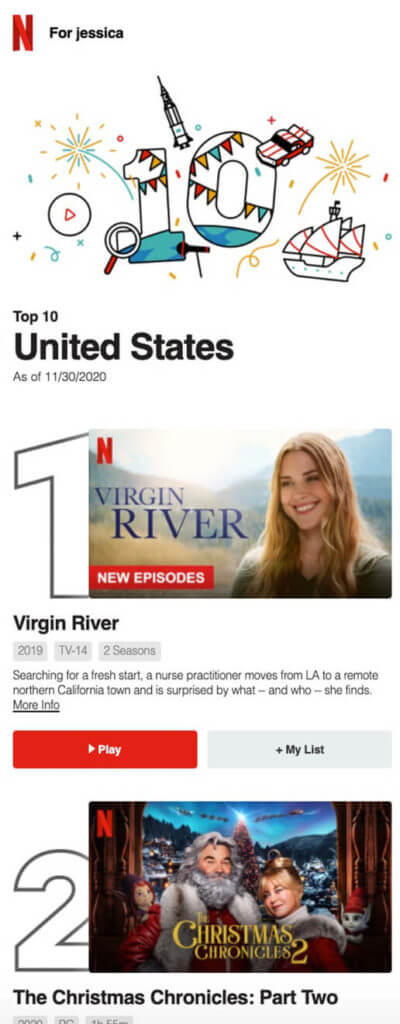Netflix began in 1997 as a competitor to Blockbuster. Now, it has as many users as the entire population of Canada, UK, and Japan combined.
Last year, 10 out of the top 15 most streamed programs in the world were produced by Netflix. It’s is still the king of streaming.
And its customers continue to renew their subscription, even after their attempts to avoid account sharing and their changes in pricings and plans, some of which now display ads.
So, how does a behemoth like Netflix create immersive experiences so captivating that the platform cannot be dethroned by its sea of competition, including Disney+, HBO and Prime Video?
Let’s break down all the elements of Netflix’s UI design and user experience (UX).
Table of contents
Netflix’s user journey: why it keeps new users hooked
Unlike other platforms, where the “wow” comes after inputting your credit card information, Netflix reels in new users right from their homepage. The design and copy are minimal, with one goal—signups.

The homepage presents a clean visual hierarchy and is free of clutter, reducing friction between the visitor and the single, straightforward call-to-action to enter an email to get started.
Their unique selling proposition also explicitly describes the biggest benefits and preempts two common FAQs: “Unlimited movies, TV shows, and more. Watch anywhere. Cancel anytime.”
The goal is obvious, the ask is clear, the task is simple.
Together, the USP and UI makeup a value proposition that is optimized for conversions. They are incredibly specific about what they do, include relevant images in the background that support the “unlimited” claim, and feature a value prop booster (i.e. “cancel any time”).
Other elements below the fold that add value include:
- Mention of the numerous platforms Netflix is compatible with, such as game consoles and connected TV devices
- An example of how to download streaming content to watch offline, as well as the ability to stream unlimited movies across all devices
- The provision of child-friendly programming options
- A Frequently Asked Questions (FAQ) section placed directly above a second opt-in form
Here, Netflix has chosen to emphasize its flexibility. Their homepage isn’t offensively long. They use minimal copy to communicate their offering, features, benefits, and FAQs to combat obstacles and sway hesitant buyers.
From there, the user embarks on a short personalized journey. Netflix highlights that there are only three steps, which work to increase motivation to complete the task at hand.

The expectancy-value theory postulates that if the expectation of completing a task is high, and the subjective value is also high, people will be more motivated to follow through. In other words, motivation = expectancy x value. If either one of these factors is missing, motivation easily disintegrates.
By centering “Step 1 of 3”, it dictates that the task will take a short amount of time, thus increasing expectancy. By this stage, the value should already be high (given their strong value proposition, USP, and UX).
On the second screen, they ask you to choose a plan. They again answer the biggest objection upfront to combat hesitancy: “No commitments, cancel anytime.”

Then, you choose your plan. They follow the rule of three when listing out their plans to keep benefits compact and engaging.
This reduces overwhelm and provides ample opportunity to opt out. They list their core benefits again to remind the user why they clicked the signup button in the first place (this works to keep the subjective value high).

Once a user has created an account, Netflix prompts them to choose a few movies or TV titles they enjoy. This data is then used as inputs in the Netflix algorithm to “jump-start” personalized recommendations (more on personalization based on their algorithm in a moment).
Post-signup, the first thing you see is an auto-playing video trailer from one of their original productions that is similar to the preferences selected during onboarding.

The primary CTA is to press “Play” to interact with the platform straight away. Akin to “frustration-free” packaging, a prominent play button motivates engagement and works to keep users on the platform longer.
Once watching commences, their behavior supersedes initial preferences as their algorithm continuously populates the homepage with newly relevant media.
Every streaming option on Netflix also allows a user to thumbs up or thumbs down the content, further instructing the preference algorithm.

For example, when you rate thumbs up for Tiger King, Netflix will show you more true crime documentary series.
The algorithm also estimates “likelihood to watch” based on dozens of metrics, such as:
- Viewing history
- Genre or category
- Time of day watched
- How long the user watched
- Devices currently streaming
- Rating history for similar content
- Other Netflix users with similar preferences on the platform
Their algorithm is continually retrained with specific user signals to improve the accuracy of their recommendations and deliver on their promise of a personalized viewing experience.
Netflix UX lesson #1
- Simplify the user interface. Make your CTA prominent and clear and state your most important benefits next to relevant images.
- Specify the number of steps to complete the signup to increase expectancy and boost motivation. Implement user testing to ensure your UX has minimal barriers to conversion.
- Overcome obstacles by addressing common questions in an FAQ section before your final CTA.
- Emphasize personalization wherever you can. Netflix has taken pains to tailor the experience to users’ expectations.
There are ways you can implement user preferences even if your platform doesn’t use intelligent algorithms. From the beginning, Netflix asked users to state their preferences. They then delivered a customized homepage based on those answers.
Seamless onboarding process across all devices
Netflix’s sign-up process can be completed on many digital devices, including:
- Android
- Computer
- iPhone, iPad, and iPod Touch
- Smart TV and Streaming Media Players
After registering, a user will be brought to a home screen. They can add a profile by clicking on a simple plus sign icon—another example of efficient UI design.
From here, the user can customize their profile name, add child restrictions, and even add up to four additional profiles for family members or friends to watch across devices anywhere in the world.

To complete the onboarding process, they can customize the type of streaming material they’ll see, including:
- Profile lock
- Maturity level
- Playback settings
- Viewing activity log
- Subtitle appearance
- Language preference
- Specific viewing restrictions
- Personalized TV show and movie suggestions
Netflix’s customization capabilities aren’t necessarily more intelligent than the competition. What helps them differentiate is that they feature them in their onboarding process instead of hiding them in the settings panel.
This allows the user to feel like they’re tailoring a unique experience from the beginning (keeping subjective value high).
Netflix UX lesson #2:
- Another nod to simplification—streamline your onboarding and login screen. Include only the most necessary buttons and copy, and where possible, exchange text for universally understood symbols.
- Give your users the ability to customize their experience. You may already have opportunities to do this in your settings, such as setting language or notification preferences.
- Let users know about this or walk them through the preference set up in the onboarding stage.
As with the rest of their user journey, the beginning is simple, easy, and customer-focused. Once users get into the platform, they’re given an abundance of choice—starting with Netflix’s original content.
Putting an emphasis on original productions
Right above the fold are the latest trending content and Netflix originals. The original productions are made to be larger than any other content to communicate their value.

Recent years have seen a steep increase in the number of households cutting ties with traditional paid TV and opting for other viewing platforms. This trend of cord-cutting and streaming preference was exacerbated by the pandemic and is forecast to continue.

“Consumers are choosing to cut the cord because of high prices, especially compared with streaming alternatives. The loss of live sports in the late years contributed to further declines. While sports have returned, people will not return to their old cable or satellite plans.”
– Eric Haggstrom, eMarketer forecasting analys
With this shift has come an increased demand for “streaming originals,” which Netflix has dominated since 2012. Over the past few years, Netflix has grown from just eight hours of original content to nearly 3,000 hours of Netflix originals.
According to Nielsen research, 10 out of the top 15 most popular original video content among streaming providers in the U.S. in 2022 were produced by Netflix.
Original Netflix series such as Orange Is the New Black, Stranger Things, and Black Mirror have become cult classics among modern television enthusiasts. More than 105 million users have watched at least one episode of Orange Is the New Black alone, according to an exclusive interview with ex-executive Cindy Holland.
Though the platform’s ease of use may have exploded their popularity, it’s these original productions that continue to add value to a user’s subscription.
The success of these series has bred innovative tactics that draw users deeper into the Netflix catalog. For each original series, Netflix will develop a dozen thumbnail options that will rotate depending on a user’s specific interests. This tactic is referred to as “artwork personalization”.
Take a Netflix original production such as Stranger Things, for instance. If a user has expressed interest in comedies, their platform will display a lighthearted Stranger Things thumbnail with the kids dressed as Ghostbusters.
But if a user were to routinely watch crime dramas, Netflix would display a more serious thumbnail of a police officer looking over a foggy pumpkin patch.

This active personalization and consideration of a user’s preferences is one reason why Netflix’s retention rate has remained so consistent over time.
How Netflix markets its trending original series

Netflix updated its product design to replace still images with video trailers that auto-play as soon as a customer starts scrolling.
In the example above, hovering over My Unorthodox Life auto-plays a video trailer about how Julia Haart went from escaping a cult to a successful New York City CEO in seven years.
This UX tactic envelops users in potential binge-watch material, providing a quick view of content that may have been skipped over without the trailer.
Netflix UX lesson #3:
- Give your high-value content pride of place. Feature it prominently, give it a badge, promote it with video, or find another way to help it stand out among the crowd.
- Continually add value to your platform. Netflix does this through its original content.
- If possible, tailor your high-value content to each segment. Netflix does this through the algorithm’s selection of content and their thumbnail design.
We’ve learned about Netflix’s simple, customer-centric user journey that gets users into the platform quickly and easily. Now let’s look at how they’ve mastered the art of keeping them there.
A retention strategy that puts personalization at the forefront
Research from Parks Associates indicates that the average Netflix user has had their subscription for more than 50 months.

On average, two-thirds of users still pay for the service one year after joining. For comparison, only 53% of Hulu users are still signed up in the same timeframe.

The popularity among existing users may also explain why new users are so attracted to the idea of subscribing.
During the early months of the COVID-19 pandemic, in which many Americans cut back on frivolous spending, Netflix experienced the biggest growth spurt in its history. The company added 15.77 million subscribers in the first three months of 2020 alone.
Netflix’s growth has slowed as the pandemic eases, but they’re still a consumer favorite.
For the users that do want to cancel, Netflix makes the process easy while still giving them opportunities to change their minds or come back at any time.

What else can we learn from the platform about how to keep users around for longer?
Personalization for the win
Personalization is a major factor in why Netflix boasts such high retention rates. As we mentioned above, even thumbnail images on Netflix are customized to match exactly what each user would prefer to see.
In each row below the fold of the homepage, there are three layers of personalization:
- The choice of a row, such as Continue Watching, New Releases, Trending Now, and Because You Watched
- The choice of titles within the row, such as new comedies within New Releases for users who prefer humor
- The ranking of chosen titles, such as placing a romantic comedy before a children’s comedy for users who enjoy more explicit material
In each row of recommendations, the Netflix algorithm weighs dozens of different factors (which they keep close to the chest) to present what they believe a user will want to watch at that moment.
For shows you’ve already started watching, the primary button changes from “Play” to “Resume”. It also prominently displays what episode you are on as well as episode progress.

Offering so much choice may seem like a luxury held in reserve for only the most successful platforms. But leveraging this power of selection has driven their success—and the competition has cottoned on. Hulu, Amazon Prime, and Disney+ all offer ample options to choose from, too.
An email marketing strategy that highlights new content

Netflix also runs a consistent email marketing strategy that highlights new content on the platform. They also invite stagnant users to check out the latest developments in shows they’ve previously watched to spark reengagement.
After an initial welcome email, they typically send out four to seven emails per month to subscribers. Though highly personalized to a user’s watching history, the email subjects typically include:
- New shows
- New movies
- New Netflix original content
- New seasons of a show a user previously watched
Netflix utilizes a standardized template that allows it to maintain consistent branding across all messaging. The template also allows for GIFs and moving images to grab and hold a reader’s attention.
Within the email, users can add shows straight to their list or get started watching.
Netflix UX lesson #4:
- Give users the opportunity to choose. Let them personalize their experience and give them as many options as you can allow.
- Make cancellation painless, but offer opportunities for users to change their minds. Netflix does this by offering to keep in touch via email (and then showing users what they’re missing regularly throughout the month).
- Remind users to return to the platform repeatedly through an engaging email marketing strategy.
Of all the streaming platforms, Netflix is the one service that continues to reign supreme, year after year. Both their cutting-edge UI and UX design and high-performing original content keep users engaged and returning.
Conclusion
From a simple interface to highly customized recommendations, Netflix has managed to create a truly immersive experience.
To replicate an experience that rivals Netflix, startup founders should pay keen attention to visual hierarchy. Avoid clutter, keep content highly personalized, and always keep your targeted call-to-action front and center.
Working on something related to this? Post a comment in the CXL community!






You’re right! Netflix has definitely created immersive usability. The #1 thing every business owner and company NEEDS to scale. If the product/service gets results – and has high usability – it’ll do exceptionally well. Great article, people underestimate the thought put into even simple campaigns done by large companies. Good stuff here!